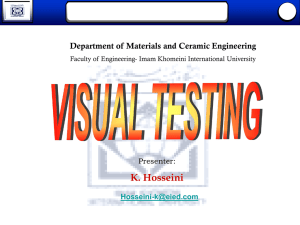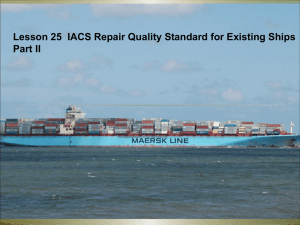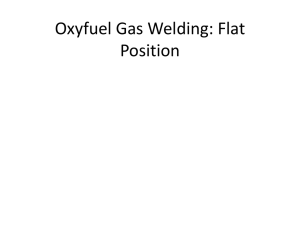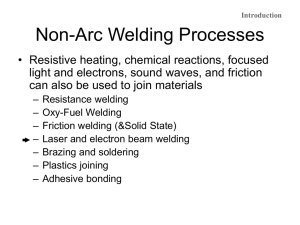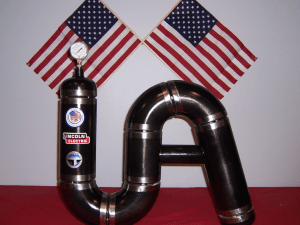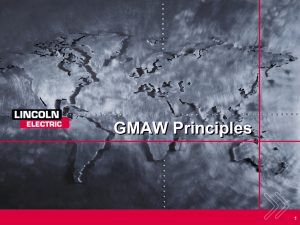Galloway AM Pure Artifical neural network
advertisement
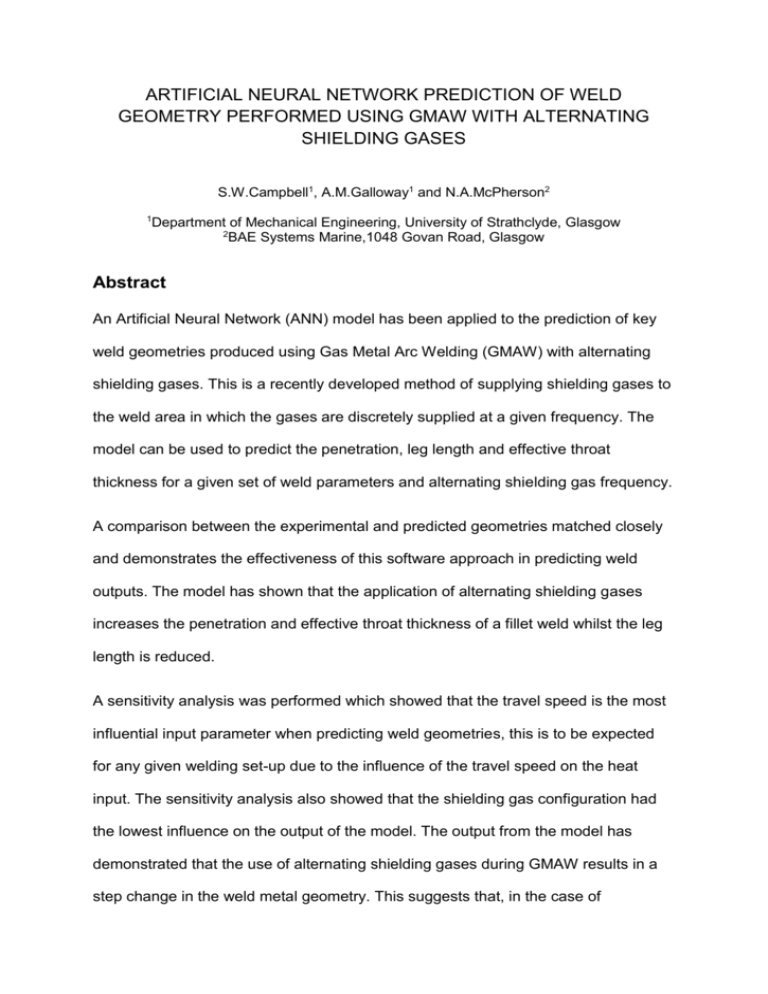
ARTIFICIAL NEURAL NETWORK PREDICTION OF WELD GEOMETRY PERFORMED USING GMAW WITH ALTERNATING SHIELDING GASES S.W.Campbell1, A.M.Galloway1 and N.A.McPherson2 1 Department of Mechanical Engineering, University of Strathclyde, Glasgow 2 BAE Systems Marine,1048 Govan Road, Glasgow Abstract An Artificial Neural Network (ANN) model has been applied to the prediction of key weld geometries produced using Gas Metal Arc Welding (GMAW) with alternating shielding gases. This is a recently developed method of supplying shielding gases to the weld area in which the gases are discretely supplied at a given frequency. The model can be used to predict the penetration, leg length and effective throat thickness for a given set of weld parameters and alternating shielding gas frequency. A comparison between the experimental and predicted geometries matched closely and demonstrates the effectiveness of this software approach in predicting weld outputs. The model has shown that the application of alternating shielding gases increases the penetration and effective throat thickness of a fillet weld whilst the leg length is reduced. A sensitivity analysis was performed which showed that the travel speed is the most influential input parameter when predicting weld geometries, this is to be expected for any given welding set-up due to the influence of the travel speed on the heat input. The sensitivity analysis also showed that the shielding gas configuration had the lowest influence on the output of the model. The output from the model has demonstrated that the use of alternating shielding gases during GMAW results in a step change in the weld metal geometry. This suggests that, in the case of alternating shielding gases, an increased travel speed is required to produce a similar weld geometry to that of the conventional Ar/20%CO2 technique. Introduction Shielding gases are fundamental to the operation of the Gas Metal Arc Welding (GMAW) process and there are a number commonly used, each with their own specific properties, i.e. ionization potential, which creates unique arc characteristics [1-7]. Shielding gases are also commonly used in a variety of premixed combinations of two or more gases in order to take advantage of the beneficial properties of each gas [8,9]. Recently however, there has been some positive research [1-4] into the effects of alternating shielding gases in both GMAW and, to a lesser extent, in Gas Tungsten Arc Welding. These studies have shown beneficial results including an increased travel speed, reduced porosity and increased strength. For example, Campbell et al. [1] reported that the use of alternating shielding gases can reduce the overall weld cost by approximately 17% whilst also considerably reducing distortion. Chang [2] reported that the use of alternating shielding gases created beneficial effects on the weld pool and, as shown in Figure 1 [3], different flow vectors were created in the weld pool for different gases used. However, when alternating between shielding gases, complex flow patterns were created which caused a dynamic action in the weld pool and this is known to be a result of the fluctuation between these individual shielding gas flow vectors. The dynamic nature of the shielding gas delivery is known to be influenced by factors such as (a) arc pressure variation, (b) variation in weld pool fluidity and (c) arc pressure peaking. Figure 1: Arc Pressure and Fluid Flow Vectors [3] As several industry sectors (e.g shipbuilding and road transportation) move towards thinner and stronger materials in order to reduce the overall mass of the structure [10,11], it is widely recognised that these thinner materials are more susceptible to distortion induced by the heat input generated by the welding processes used during fabrication. Distortion is a result of the non-uniform expansion and contraction of the weld material due to the heating and cooling cycle [11] and is notoriously difficult to predict [12] and mitigate. However, the effort required to rectify the distortion from the steel structure is highly resource intensive. For that reason it is beneficial to eliminate as much distortion at source as possible and this is largely achievable through good practices, mainly related to reducing the heat going into the steel structure and the concentration of heat in specific areas. Further, there is an increasing demand for quality prediction in today’s ever increasing automated society and it is imperative that there is a high level of consistency in the process in order to satisfy this demand. While the external fillet weld geometry can be measured, there is no way of knowing the penetration of the weld without sectioning it. As both of these geometry details are important in terms of weld integrity, it is clear that an optimised approach needs to be taken such that the maximum penetration and effective throat is deposited to satisfy the structural integrity demands with the converse being the case in terms of minimising the weld heat input and final distortion. Hence, in an attempt to achieve the optimum weld geometry conditions, the implementation of various model simulation environment software, such as Artificial Neural Networking (ANN), offers considerable predictive strength to this optimisation approach. ANNs are mathematical or computational models that are able to capture and represent complex input-output relationships. They are distributed, adaptive, generally nonlinear learning machines built from many different processing elements (PEs) [13]. The interconnectivity of the PEs defines the topology of the network. There are three main network topologies commonly implemented: Multilayer Perceptron (MLP) Generalized Feed-Forward (GFF) Modular Feed-Forward (MFF) Neural networks can be used to predict any process as long as sufficient data is generated to accurately train the model. They can develop patterns and detect link/trends that are too complex to be observed via other techniques, therefore allowing for the strong indicators of new situations of interest. ANNs can be employed to accurately predict mechanical properties and other important weld characteristics without the need for destructive testing, whilst precise models will provide confidence in the welds produced. The basic architecture of an ANN is shown in Figure 2 and consists of interconnected processing elements in the different layers of the system: An input layer - represents the raw data that is fed into the system One or more hidden layers - the output of which is determined by the activities of the inputs and the weights of the connections An output layer - conveys the signals to the environment and is dependent upon the processes and weights of the hidden units. Figure 2: Multilayer Perceptron Architecture with 1 Hidden Layer This type of computational model can be effectively applied to the welding process where the input layer consists of the welding parameters and the output layer is made up of the weld geometry, mechanical properties and other factors as a consequence of the input parameters. ANNs have been used extensively in the prediction of weld characteristics such as mechanical properties [14-18] and have been shown to be fairly accurate in determining tensile strength, hardness, elongation and impact energy. They have been used to determine the weld quality [19] based upon differing input settings including current, voltage and gas compositions. ANNs have also been implemented for the prediction of weld induced deformation [20,21] and weld geometry [22-24]. Although ANN have been previously used for the prediction of various welding parameters, there have been no publications for the prediction of welding parameters whilst implementing this novel technique of alternately supplying shielding gases. Experimental Set-up The material used throughout was 6 mm thick DH36 grade steel in the form of 60 mm wide bar with a typical chemical composition shown in Table 1. The bars were tacked together in the form of an inverted ‘T’ as shown in Figure 3. Element Chemical Composition (wt. %) Carbon 0.15 Silicon 0.35 Manganese 1.38 Phosphorous 0.013 Sulphur 0.012 Chromium 0.017(trace) Molybdenum 0.001(trace) Nickel 0.018(trace) Aluminium 0.026 Copper 0.01(trace) Niobium 0.025 Nitrogen 0.003 Table 1: Chemical Composition of DH36 Steel (trace indicates non-deliberate additions) 6 mm a c d b e 6 mm Figure 3: Weld Detail Showing Geometries Measured Where: a - Effective Throat Thickness b - Horizontal Leg Length c - Vertical Leg Length d - Penetration Horizontal Leg e - Penetration Vertical Leg The average welding parameters are shown in Table 2. The gas flow was controlled using an electronic control unit, which allowed the alternating frequency to be accurately set prior to welding whilst implementing an oscilloscope for validation. The basis of the unit was two 555 timing circuits. A 555 timer is an extremely versatile integrated circuit used in a variety of applications and commonly implemented in timing circuits as a result of the controllability of frequency output. When in ‘astable’ mode, the 555 timing circuit will generate a continuous square wave at a specified frequency, the output controlled the current supply to two solenoid valves in order to regulate the flow of each gas. The unit incorporated an invert function to supply opposite signals to each valve for alternation precision. At present, the device used for alternating the shielding gases is an experimental unit that is not currently commercially available. However, the unit is a simple set-up which was minimal in cost to generate. The potential savings and benefits [1] of the system are likely to substantially outweigh any modest capital investment required to implement the technology on a commercial scale. Shielding Gas Gas Flow Rate Voltage Current Travel Speed Configuration (l/min) (V) (A) (mm/s) Ar/20%CO2 Constant 15 l/min 22, 24, 26 155 2, 2.5, 3 Ar/20%CO2 Alternating @ Helium 2, 4, 6, 8 Hz 15 l/min 22, 24, 26 155 2, 2.5, 3 Shielding Gas Table 2: Typical Welding Parameters There are various filler materials used in industry depending upon the application and the ability of each to be used in a particular weld position including solid wire, metal cored wire and flux cored wire. 1 mm metal cored wire (EN 758: T46 4 M M 1 H5), which has a typical all weld metal chemical composition shown in Table 3, was used throughout experimentation with a constant feed speed of 90 mm/s. Element Chemical Composition (wt. %) Carbon 0.05 Silicon 0.5 Manganese 1.3 Phosphorous <0.015 Sulphur <0.015 Table 3: Chemical Composition of Filler Wire All experimental welds were deposited on an automatic welding rig where the plate, held rigid, moved at a pre-set speed under a fixed welding nozzle. The nozzle used was adapted so as to allow the helium to be directly supplied to the welding zone, Figure 4. In each case the welds were produced using a torch pre-set at a 45˚ angle and fixed in position. Figure 4: Welding Torch Showing Adapted Nozzle A, pre-calibrated, Portable Arc Monitoring System (PAMS) unit was used throughout to accurately obtain the welding arc voltage and current. The on-board A-D converter of the PAMS unit has a 14-bit resolution which results in the voltage being accurate to approximately 0.012 V and the current to approximately 0.12 A. The sample frequency of the unit was 5 kHz and will therefore accurately represent the average parameters even when alternating between gases since the sample frequency (5 kHz) is very much greater than the alternating frequency (2-8 Hz). Model Development The software implemented for this study was NeuroSolutions which had previously been used successfully for the prediction of weld geometries [24] and distortion [20]. A total of 45 samples were produced (9 for each gas configuration), 40 samples were used for the training of the model whilst the remaining 5 (1 for each gas configuration) for testing. The same 5 test data sets were used throughout in order to produce a direct comparison on the accuracy of the model using each of the topologies. Throughout the model generation, each model was run three times and the average error taken. This was done since the same topology with the same training data can produce so many different sets of final weights. There are three main reasons behind this: There are many symmetries in the input-output mapping created by the MLP. There is no guarantee that the problem has a single solution. The final weights are obtained in an iterative fashion from random initial values. The following network topologies were considered: Multilayer Perceptron (MLP) Generalized Feed-Forward (GFF) Modular Feed-Forward (MFF) Mathematically, the output from each of the models is the same and can be represented as shown in Eqn. 1: Eqn. 1 Where: is the output is the input sample is the weight of the sample is the number of samples It was found that although the MLP topology produced a higher mean square error than the GFF and MFF topologies, when comparing the percentage errors of the test data sets it was found that the MLP topology produced the lowest error and was therefore selected. There is an optimum number of iterations for training the model and consequently the number of learning iterations had to be determined. The model was trained using between 4,000 and 20,000 iterations, with 8,000 iterations producing the lowest percentage error and therefore the most accurate approximation. Contrary to what would be logically expected, the neural network can become over trained and the percentage error actually increases above 8,000 iterations. [13] The number of hidden layers of processing elements (PEs) that are not connected directly to the external world was established. There are two extreme cases for the number of hidden layers: either the network has too many PEs to do the job, or it has too few. The model was run with 1-5 hidden layers, it was found that the 1 hidden layer model returned the lowest percentage error of the test data. Momentum learning was then applied to the model which is an improvement to the straight gradient-decent search in the sense that a memory term is used to speed up and stabilise convergence. The use of a momentum coefficient helps stop the learning process getting stuck in a local minimum or flat spot. In momentum learning, the equation to update the weights becomes Eqn. 2: Eqn. 2 Where: is the weight that connects the PE to the PE is the iteration number is the step size is the computed error at the is the flow of activations at the PE PE is the momentum constant The use of momentum learning results in the weighting changing proportionally to how much they are updated in the previous iteration. The momentum constant can have a value of between 0 and 1. It was determined that a value of 0.7 produced the most accurate model. The final stage in the model development is specifying when the weights are updated. On-line learning updates the weights after the presentation of each data set. In contrast, batch learning updates the weights after the presentation of the entire training set. It was found that batch learning updates returned the lowest final error. After this procedure, it was determined that the following network architecture provides the best fitting model: Model Topology - Multilayer Perceptron Iterations - 8,000 Hidden Layers - 1 Momentum Coefficient - 0.7 Weight Updating - Batch Prediction of Weld Geometry The model generated has been shown to accurately represent the weld penetration, leg length and effective throat thickness, by comparing the actual values with those predicted by the NeuroSolutions package as shown in Figure 5. The software has been shown, on average, to overestimate weld penetration by 0.06 mm and underestimate leg length and effective throat thickness by 0.23 mm and 0.52 mm respectively. When compared with the experimental data, this equates to percentage errors of 4.9%, 3.4% and 9.6% respectively which is deemed as highly accurate in any ANN study. Figure 5: Comparison of Experimental and Predicted Geometries The trained model was then applied to a given set of input parameters with the only variable being the shielding gas composition. The results, Figure 6, show that the addition of helium has resulted in an increase in penetration, due to the narrower, more concentrated arc column that helium produces [25] as depicted in Figure 7. Figure 6: Effect of Shielding Gas Configuration on Predicted Penetration Figure 7: Temperature Contours for (a) Argon and (b) Helium at a 200 A Welding Current [25] Additionally the prediction has shown that increasing the frequency of shielding gas alternation from 2 Hz to 8 Hz resulted in a 0.3 mm increase in penetration. As a consequence, for a given level of penetration, the travel speed can be increased reducing the cost of the weld. It has been determined that for an equivalent level of penetration, the travel speed for alternating shielding gases can be increased, on average, by 28% over the Ar/20%CO2 base case therefore has the potential to greatly increase the productivity of the welding process. This confirms the findings of Campbell et al. [1] which demonstrated that the travel speed can be increased by 18% on the 2nd pass and 82% on the 3rd pass, thus resulting in an overall time reduction of 22%. It has been widely publicised that plate distortion is a function of heat input. It has been reported that lower heat input welding processes result in less heat induced distortion [1,26]. The decrease in heat input, which would be as a result of the increased travel speed used to produce the equivalent levels of penetration when using alternating shielding gases, will also have beneficial effects with regards to weld induced distortion. The model has also shown that the application of alternating shielding gases results in a shorter leg length, Figure 8, thus confirming the experimental results and is a consequence of the concentrated arc column that helium produces [25]. The effective throat thickness is shown to increase with the use of alternating shielding gases, Figure 9, this is primarily linked to the added convexity of the weld metal and increased penetration with the addition of helium. Figure 8: Effect of Shielding Gas Configuration on Predicted Leg Length Figure 9: Effect of Shielding Gas Configuration on Predicted Effective Throat The macro images, Figure 10, show that a typical alternating shielding gas weld produces a narrower weld with increased convexity, this along with the results generated by the ANN model show that there is a trend between the shielding gas and the weld geometry. As reported by Kang et al. [3], alternating shielding gases creates complex flow vectors within the molten weld pool whereas constant gas flows produce a steady flow vector. It was reported that helium produces a flow vector which circulates inwards, which will result in a narrower, more convex, weld profile. This is most probably due to the Marangoni effect in that the shielding gas configuration affects the surface tension of the weld, resulting in a thermo-capillary convection phenomenon. As the Marangoni effect is governed by the temperature gradient on the weld pool surface and the temperature coefficient of the surface tension, it follows that, as helium has a higher arc power density than argon it consequently produces a smaller cathode spot, an increased electromagnetic force and an increase in the temperature gradient of the weld pool surface. Consequently, helium will have a greater Marangoni effect than argon and will thus create greater surface tension which explains the narrower weld with greater penetration shown in Figure 10. (a) Figure 10: (b) (a) Weld profile showing the concavity of a typical weld produced using Ar/20%CO2 (b) Weld profile showing the convexity of a typical weld produced using alternating shielding gases Sensitivity Study A sensitivity study is an extremely powerful tool in the NeuroSolutions package which can be used to determine the influence of each of the input variables on the output of the model. In order to perform the sensitivity analysis, the neural network must first be trained as normal. The analysis then perturbs each of the inputs, one at a time, by a known variance from the mean whilst keeping all other variables at their respective means and measuring the change in the output. The sensitivity for the input k can be expressed as shown in Eqn. 3: Eqn. 3 Where: is the sensitivity for input k is the output obtained with the weights fixed for the pattern o is the number of network outputs is the number of patterns is the variance of the input perturbation This, when applied across the training data, can compute how much a change in the input affects the output. The sensitivity of a model is not only important in the context of this model, i.e. determining the key factors for weld penetration etc., but also aids the training of the model with inputs of high sensitivities having more importance in the mapping. Sensitivity of Results The results of the sensitivity study, Figure 11, show that the travel speed is the most influential input variable in affecting the output variables. This is to be somewhat expected since the heat input, Q, is directly related to the travel speed through Eqn. 4: Eqn. 4 Where: is the voltage (V) is the current (A) is the thermal efficiency factor is the travel speed (mm/s) Figure 11: Sensitivity Analysis Results The sensitivity study results show that the shielding gas configurations have the lowest contribution of the inputs on the weld geometries. However, this cannot be taken at face value and is a result of the sensitivity study perturbing the alternating frequency e.g. comparing an alternating frequency of 5.9 Hz with 6 Hz. As can be seen in Figures 6, 8 and 9, although there is a slight change in the geometries using different frequencies of alternation, the greatest step change is observed between the use of premixed Ar/20%CO2 and alternating at 8 Hz, although, in fact, any frequency of alternation provides a similar step change. Figures 6, 8 and 9 also show that alternating shielding gases have a positive effect on the level of weld penetration whilst also reducing leg length and increasing the effective throat thickness. Conclusions A comparison of experimental and predicted results show that ANN software can be successfully employed to generate a model to predict multiple weld geometries. The results of the sensitivity analysis were in agreement with both findings of the experimental investigations and findings in other literature. It has also been found that by training the model in reverse, the model can be implemented to determine the weld parameters required to produce a weld of specified geometry. The implementation of an ANN model for the prediction of the weld parameters necessary to satisfy a given geometry requirement can reduce the time required compared to determining the parameters experimentally, producing a noticeable economic benefit. The accuracy of prediction is restricted by the data spread for a given parameter in the data used to train the model. Therefore the wider the range of data, the more accurate the model will be in predicting outside of the training data spread. As a consequence of computational models becoming ever more advanced, their ability to accurately predict key weld geometries for a given set of parameters will help increase confidence that the resultant weld will be of this desired quality. Acknowledgements The authors would like to acknowledge the funding provided by BAE Systems Marine which made this research possible. Additional thanks are due to Dr. Martyn Lightfoot of the Shipbuilders and Shiprepairers Association and Simon Beckett of BAE Systems for their support. References 1. Campbell. S.W., Galloway. A.M., McPherson. N.A. Techno-Economic Evaluation on the Effects of Alternating Shielding Gases for Advanced Joining Processes. Proceedings of IMechE Part B: Journal of Engineering Manufacture, In Press. 2. Chang, Y. H. 2006. Improve GMAW and GTAW with Alternating Shield Gases. Welding Journal, 85(2): p41-43. 3. Kang, B.Y., Yarlagadda K.D.V. Prasad, Kang, M.J., Kim, H.J., Kim, I.S. 2009. Characteristics of Alternate Supply of Shielding Gas in Aluminium GMA Welding. Journal of Materials Processing Technology, 209: p4716-4121. 4. Kang, B.Y., Yarlagadda K.D.V. Prasad, Kang, M.J., Kim, H.J., Kim, I.S. 2009. The Effect of Alternate Supply of Shielding Gases in Austenite Stainless Steel GTA Welding. Journal of Materials Processing Technology, 209: p4722-4127. 5. Marya, M., Edwards, G. R., and Liu, S. 2004. An Investigation on the Effects of Gases in GTA Welding of a Wrought AZ80 Magnesium Alloy. Welding Journal, 83(7): p203-212. 6. Tani, G., Campana, G., Fortunato, A., Ascari, A. 2007. The Influence of Shielding Gas in Hybrid Laser-MIG Welding. Applied Surface Science, 253: p8050-8053. 7. Galloway, A.M., McPherson, N.A., Baker, T.N. An Evaluation of Weld Metal Nitrogen Retention and Properties in 316LN Austenitic Stainless Steel. Proceedings of the Institution of Mechanical Engineers, Part L: Journal of Materials: Design and Applications. In Press. 8. Jeffus, L.F. 2002. Welding: Principles and Applications. Cengage Learning, p253-255. 9. ASM Metals Handbook, 8th Edition, Vol. 6 Welding and Brazing, p85. 10. McPherson, N. 2010. Correcting Thin-Plate Distortion in Shipbuilding. Welding Journal, 89(1): p30-34. 11. Deng, D., Murakawa, H. 2008. Prediction of Welding Distortion and Residual Stress in a Thin Plate Butt-Welded Joint. Computational Materials Science, 43(2008): p353-365. 12. Hong, L., Ren, H. 2006. Simulation of Welding Deformations of Ship Structures. Key Engineering Materials, 324-325: p651-654. 13. Principe, J.C., Euliano, N.R., Lefebvre, W.C. 2000. Neural and Adaptive Systems: Fundamentals Through Simulations. John Wiley & Sons, Inc. 14. Sterjovski, Z., Nolan, D., Carpenter, K.R., Dunne, D.P., Norrish, J. 2005. Artificial Neural Networks for Modelling the Mechanical Properties of Steels in Various Applications. Journal of Materials Processing Technology, 170: p536– 544. 15. Pal, S., Pal, S.K., Samantaray, A.K. 2008. Artificial Neural Network Modeling of Weld Joint Strength Prediction of a Pulsed Metal Inert Gas Welding Process Using Arc Signals. Journal of Materials Processing Technology, 202: p464-474. 16. Lakshminarayanan, A.K., Balasubramanian, V. 2009. Comparison of RSM with ANN in Predicting Tensile Strength of Friction Stir Welded AA7039 Aluminium Alloy Joints. Transactions of Nonferrous Metals Society of China, 19: p9-18. 17. Reddya, N.S., Krishnaiahb, J., Hong, S., Lee, J.S. 2009. Modeling Medium Carbon steels by using artificial neural networks. Materials Science and Engineering A, 508: p93-105. 18. Ates, H. 2007. Prediction of Gas Metal Arc Welding Parameters Based on Artificial Neural Networks. Materials and Design, 28: p2015-2023. 19. Pal, S., Pal, S.K., Samantaray, A.K. 2010. Prediction of the Quality of Pulsed Metal Inert Gas Welding Using Statistical Parameters of Arc Signals in Artificial Neural Network. International Journal of Computer Integrated Manufacturing, Vol. 23, No. 5: p453–465. 20. Lightfoot, M.P., Bruce, G.J., McPherson, N.A., Woods, K. 2005. The Application of Artificial Neural Networks to Weld-Induced Deformation in Ship Plate. Supplement to the Welding Journal, p23-26. 21. Lightfoot, M.P., McPherson, N.A., Woods, K., Bruce, G.J. 2006. Artificial Neural Networks as an Aid to Steel Plate Distortion Reduction. Journal of Materials Processing Technology, 172: p238–242. 22. Nagesh, D.S., Datta, G.L. 2008. Modeling of Fillet Welded Joint of GMAW Process: Integrated Approach Using DOE, ANN and GA. Int J Interact Des Manuf, 2: p127-136. 23. Nagesh, D.S., Datta, G.L. 2010. Genetic Algorithm for Optimization of Welding Variables for Height to Width Ratio and Application of ANN for Prediction of Bead Geometry for TIG Welding Process. Applied Soft Computing, 10: p897-907. 24. Beckett, S., MacPherson, M.J., McPherson, N.A. 2011. Improved Welding Control of Automated Fillet Welding for Ship Structures Using Artificial Neural Networks (ANN). Presented at JOM 16 Conference, May 2011, Helsingø. 25. Jönsson, P.G., Eagar, T.W., Szekely, J. 1995. Heat and Metal Transfer in Gas Metal Arc Welding Using Argon and Helium. Metallurgical and Materials Transactions B, 26B p383-395. 26. Deng, D., Murakawa, H. 2008. FEM Prediction of Buckling Distortion Induced by Welding in Thin Plate Panel Structures. Computational Materials Science, 43: p591-607.

